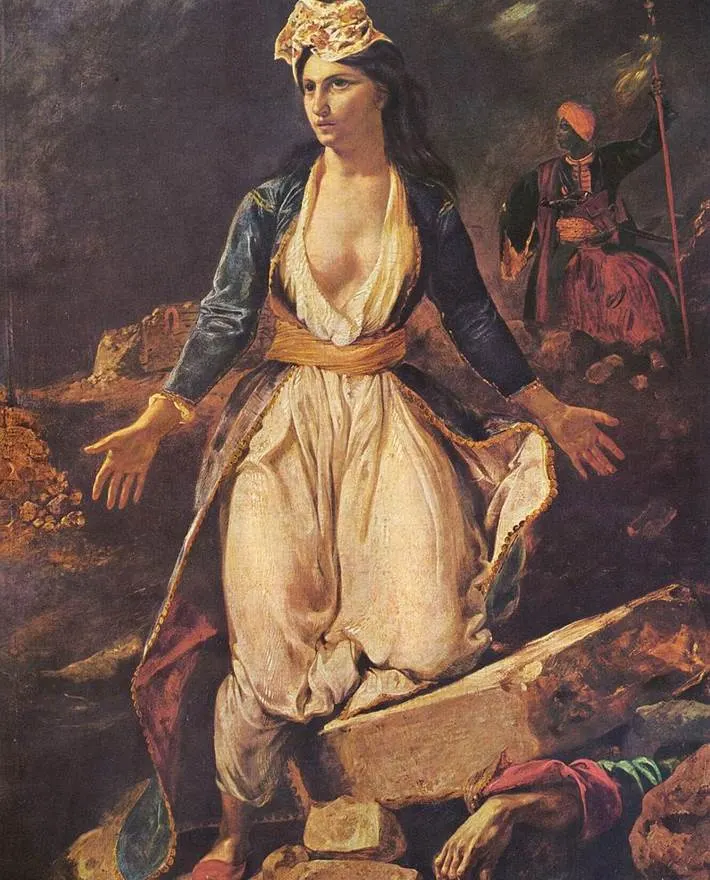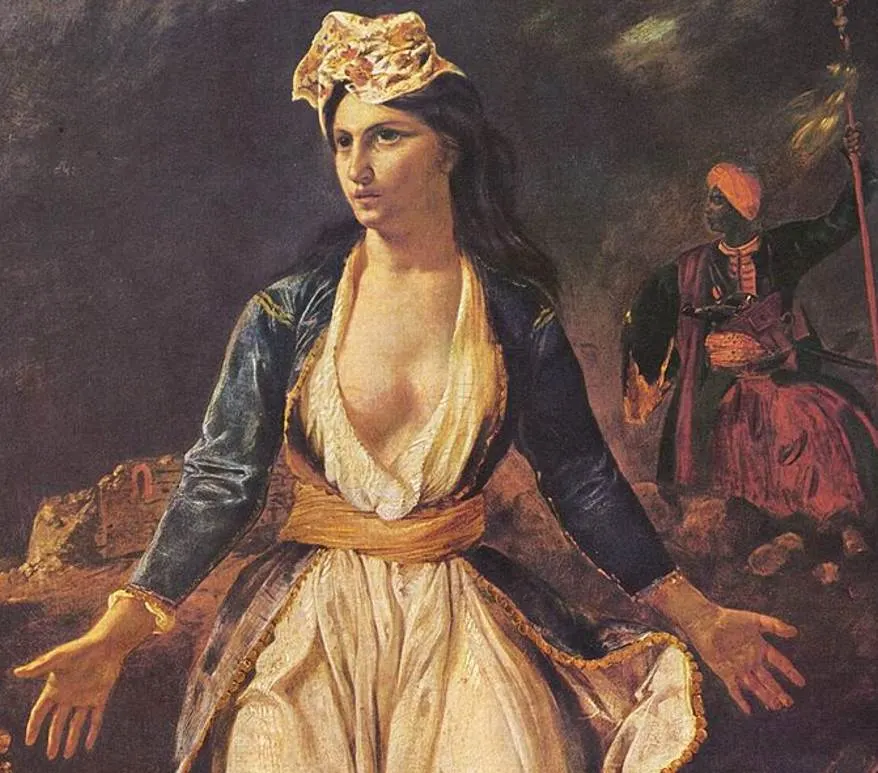It’s hard to believe that the first paintings by Eugène Delacroix were influenced by his training in the Neoclassical style. After all, Jean-Jacques Louis (1748-1825), the Greatest Neoclassical artist at the time dominated the art scene during the end of the 18th and beginning of the 19th centuries.
One moment in the early career of Eugène Delacroix (1798-1863) changed all that and the result was an oeuvre of highly intense and dramatic paintings by one of the most renowned Romantic artists in history.
In this article, you’ll discover some of the most interesting facts about Greece on the Ruins of Missolonghi, a remarkable work of art for multiple reasons.
1. It was painted in the year 1826
Eugène Delacroix was one of the leading artists of the French Romantic School in the 19th century. He started as a student of Neoclassical art and some of his first works resembled paintings by Raphael, one of the greatest masters of the Renaissance.
This all changed when the artist laid his eyes upon a work by his colleague and friend Théodore Géricault (1791-1824) called “The Raft of the Medusa” (1819). From then on, his works were defined by an overly dramatic effect and real human emotion as we can see in this painting.
The first major work of Delacroix was “The Barque of Dante,” a painting that was accepted for the Paris Salon in 1822. He completed Greece on the Ruins of Missolonghi just 4 years later during 2 months of hard work in 1826.

2. It depicts the conclusion of a year-long siege that took place in Greece
As the name of the painting implies, it depicts the conclusion of the Third Siege of Missolonghi, an event that lasted between April 15, 1825, and April 16, 1826.
During this event, the Ottoman forces besieged the town of Missolonghi, a relatively small town and the capital of the Aetolia-Acarnania region in western-Central Greece.
The siege ended when many of the Greek rebels inside the town who were suffering from famine and epidemics tried to break free. The result was that most of the Greeks were slaughtered and over 8,000 people lost their lives.
3. It wasn’t the first time that the war in Greece inspired Delacroix

The atrocities in Greece had been going on for multiple years, ever since the Greek rebels started their War of Independence on March 25, 1821. The official declaration of Independence happened on January 15, 1822.
Eugène Delacroix had felt sympathy for the Greeks’ cause ever since this war started and his second major painting depicting another atrocity known as “The Massacre at Chios.” He completed this work in time for the Paris Salon of 1822 where it was put on display.
The depiction of the massacre sent shockwaves through the world of art, mainly because it didn’t feature some sort of hero and the graphic images of the dying Greeks were as raw as they could be.

4. The depicted woman represents a surrendering Greece
Delacroix changed his ways quite a bit in Greece on the Ruins of Missolonghi because the depicted female takes up nearly the entire composition.
She can be seen wearing a traditional Greek costume which means she is the physical representation of Greece. She spreads her arms in surrender, a gesture that can also be interpreted as a sign of sadness.
A hand of a crushed victim can be seen sticking out of the rubble as well, and in the background, we can see a dark figure wearing a yellow turban who represents the Ottoman forces who committed this atrocity.
5. The painting is on display in a famous museum in France
One of the largest museums in France outside of Paris is located in the city of Bordeaux and is called the “Musée des Beaux-Arts de Bordeaux.” It was established in the year 1821 and houses a collection of fine art ranging from the 15th century to the 20th century.
Greece on the Ruins of Missolonghi can be found in the North Wing of this museum along with various other works created by Realism artists and Impressionist artists during the 19th century.

More interesting facts about Greece on the Ruins of Missolonghi
6. Delacroix was known for his immense works of art, often covering entire walls. While this is far from being his largest work, it’s still pretty big with dimensions of 208 × 147 centimeters (82 × 58 inches).
7. It wasn’t the first time that Delacroix was inspired by the Greeks and their war for independence and wasn’t the final time that he depicted a woman as a hero.
His most famous work, “Liberty Leading the People” (1830) also depicts a bare-breasted woman as the protagonist. This work represents the July Revolution which happened the year he painted it and the woman representing liberty is now considered to be a symbol of France.
This painting is a bit larger than the work discussed in this article as it has dimensions of 260 × 325 centimeters (102.4 × 128.0 inches). It’s one of the main attractions at the Louvre Museum in Paris.

8. There’s a reason why Delacroix was so interested in the Greek War of Independence, and that’s mainly because of an unlikely hero who fought in it who the artist admired deeply.
English poet Lord Byron (1788-1824) was one of the leading figures of the Romantic movement in the early part of the 19th century. He led a campaign during this war and died from fever following the First and Second Siege of Missolonghi.

9. Although the Greeks ended Missolonghi ended up being slaughtered, these people eventually became martyrs for their country.
The harsh treatment of the Greeks by the Ottoman Empire lead to the intervention of external powers who helped to recognize the Greek independence in 1830. The painting by Delacroix emphasizes the sympathy felt for the Greeks in Western Europe.
10. The woman representing Greece can be seen wearing a white robe and a blue coat. This was traditionally the attire worn by the Virgin Mary during the Immaculate Conception.
This Roman Catholic doctrine states that Mary was completely free of sin the moment of her conception. This notion has led art historians to believe that the woman is the personification of Greece as the Virgin Mary as she is about to be slaughtered by the evil forces who besieged her.

